


The infant and toddler period is an important development stage. Health promoting behavior performed in this period can have great influence to those infants and toddlers on their health habits and levels in adolescent and adult lives, not to mention the development and health of subsequent childhood period (Belsky,1984). Health promoting behavior is the behavior motivated to realize health potential, and the efforts to expand positive potentials of health with the goal of reaching the optimal health conditions (Wu & Pender, 2001). For infants and toddlers who are immature physically, physiologically, and cognitively, and are highly sensitive to infectious diseases, the family environment where their parents take care of them are essential element for their normal growth (Kim, 2009; Crimic, et al, 1983). Given that health promotion is performed by their care-takers including their parents (Jeong, 2009), parenting burnout of the major care-taker will have great influence on promoting health of infants.
Since infants and toddlers from 1 month old to 3 years old are immature physically, physiologically, and cognitively, they are highly vulnerable to infectious diseases. Thus, they are exposed to the risk of various accidents and diseases as well as infectious diseases, oral health problems, unbalanced diet, anemia, and fatness, etc. (Kim, Kang, & Kwan, 2007). The infant and toddler period is the time when physical and mental growth and development are the fastest in one's life, and the health of this period affects life-long health (Kim, 1997). In particular, they are unable to identify their health problems and take proper measures for them (Edelman & Mandle, 1994). In addition, the infant and toddler period, in continuous development stages, is the time when the child develops trust to his or her care-taker, and acquires autonomy. Thus, the role of mother who contacts the infant or toddler most often, and spends most of time with the infant is important (Kim, 1991).
In this period of time in one's life, infants and toddlers tend to mimic and depend on the persons who take care of them. Accordingly, if a mother's parenting method is wrong, it can directly and indirectly affect formation of the infant's habits, hindering normal development and affecting infant's health to a great extent (Kim, 1997). That is, the good health promoting behavior of mother can serve as fertilizer for good environment for growth and development of infants. Consequently, mother who provides care as an important supporting system is responsible for the problems related with health for infants and toddlers, and active participant in performing direct and fundamental activities to maintain and promote infants and toddlers (Igoe, Giordano, 1992). Thus, the health promoting behavior mother does for her infant or toddler is the cornerstone for growth and development of infants, and plays a crucial role in forming healthy habits and improve heath conditions (Pender, Walker, Sechrist & Frank-Stromborg, 1990). Therefore, it is as important as anything else to find out factors affecting the practice of health promoting behavior of mother.
Existing researches have found that some elements affect health promoting behavior: Support of parents has positive effects on health promoting behavior of infants and toddlers (Mitch Blair, 2010); self-esteem, self-efficacy, and stress also have effects on it (Yoo et al., 2010; Jeon & Kim, 2010; Rye & Park, 2007: Park, 2003). Kim et al. (2007) developed a tool to measure health promoting behavior, and Kim et al. (2008) measured health situations of infants and toddlers. Jeong (2009)'s study on Korean mothers and Shin (2010)'s study on mothers of multicultural families found that parenting efficacy of infants and toddlers has positive relationship with health promoting behavior. However, there have not been sufficient researches on the elements affecting mothers for their health promoting behavior, and there has not been any research on the influence of parenting burnout on health promoting behavior.
Thus, this research, using mothers who take care of infants and toddlers as research objects, intended to examine the degrees of health promoting behavior for infants and toddlers and parenting burnout, and the effect of the former on the latter. Specific purposes of the research are as follows.
First, it examines the degrees of health promoting behavior for infants and toddlers of mother and parenting burnout.
Second, it examines the relationship between health promoting behavior for infants and toddlers of mother and parenting burnout.
Third, it examines the effect of health promoting behavior for infants and toddlers of mother on parenting burnout.
This research is a descriptive survey research to examine health promoting behavior on parenting burnout, using a structured questionnaire given to 106 mothers who visited the child and adolescent department of the hospital.
1) Parenting burnout
To measure parenting burnout of mothers, the 15-question scale which is MBI (Maslach Burnout Inventory) developed by Maslach and Jackson (1981) and Han (2010) translated and used. 15 questions consist of exhaustion (2 questions), apathy (4 questions), self-esteem (6 questions), and depletion (3 questions). Specific questions for exhaustion are 'I am completely worn out taking care of my child'; 'I feel tired in the morning thinking that I have to care my child.' A question for apathy is 'I become cynical on caring my child'. Examples of questions on self-esteem are 'I think I care my child well'; 'I feel that I effectively contribute to caring my child'. Each question is Likert-type 5-point scale where 'not at all' is 1 point and 'Definitely yes' is 5 points. Among them, the scale for self-esteem is designed to calculate reversely. Internal consistency reliability Cronbach's ɑ value of the data was .651.
2) health promoting behavior
health promoting behavior in this research is defined as individual or community activities to promote healthy life style, and a comprehensive behavior done in the direction of enhancing welfare level and maintaining and improving self-realization and satisfaction (Wu & Pender, 2001). To measure health promoting behavior performed by mothers for their infants and toddlers, the tool for health promoting behavior of infants and toddlers developed by Kim et al. (2007) was revised to suit the purpose of this research. The number of questions used to measure performance level was 21, and each question consists of 4-point scale where 'not at all' is 1 point and 'does very well' is 5 points. The higher points are, the more actively mothers perform health promoting behavior. Internal consistency reliability Cronbach's ɑ value of the data was .868.
3. Research objects and data collection
The data for this research was made by self-report of respondents using a structured questionnaire. The survey period was from February 1 to March 30, 2014. The researcher visited a medical center for child and adolescent diseases located in Eumseong-gun, Chungbuk province, and explained the research purposes to the head of the center. Getting approval from the head, the researcher educated the survey assistant on the contents of the survey and how to do survey. The survey assistant approached mothers who visited the medical center to ask to participate in the survey. She distributed the questionnaire to the mothers after explaining them on the research purposes, confidentiality of their answers, expected time to fill out the questionnaire, how to fill out it, and their freedom to stop answering the questions if they wanted. It took about 10 minutes to finish filling out the questionnaire. 140 copies of it were distributed, but 116 copies, 86% of them, were collected. Excluding 10 copies which had some problems, 106 copies were used for analysis.
The data were analyzed using the SPSS Win 14 program. The attributes of respondents, parenting burnout, and health promoting behavior were analyzed by descriptive statistics. The relationship between parenting burnout and health promoting behavior was analyzed by correlation analysis, and the effect of health promoting behavior on parenting burnout was analyzed by multiple regression analysis.
The age distribution of respondents was as follows: 32 mothers (32.1%) of 30 years old or below; 97 mothers (63.2%) from 31 to 41 years old; 5 mothers (4.7%) of 41 years old or above. The educational levels of them were as follows: 1 mother (0.9%) below high school; 40 mothers (37.7%) of high school graduation; 62 mothers (58.5%) of college graduation; 3 mothers (2.8%) of graduate school graduation. 29 respondents (27.4%) had jobs, while 77 (72.6%) didn't. Family monthly income level distribution of them was as follows: 38 (35.8%) were below 2 million won; 42 (39.6%) were 2~3 million won; 18 (17%) were 3~4 million won; 8 (7.5%) were over 4 million won. Gender distribution of infants and toddlers was 52 males (49.1%) versus 54 females (50.9%), roughly equal distribution. The age distribution of infants and toddlers was as follows: 1-12 months 42 (39.3%) were from 1~12 months old; 37 (34.6%) were 13~24 months old; 27 (25.2%) were 25~36 months old.
[Table 1.] Characteristics of the Participant (N=106)
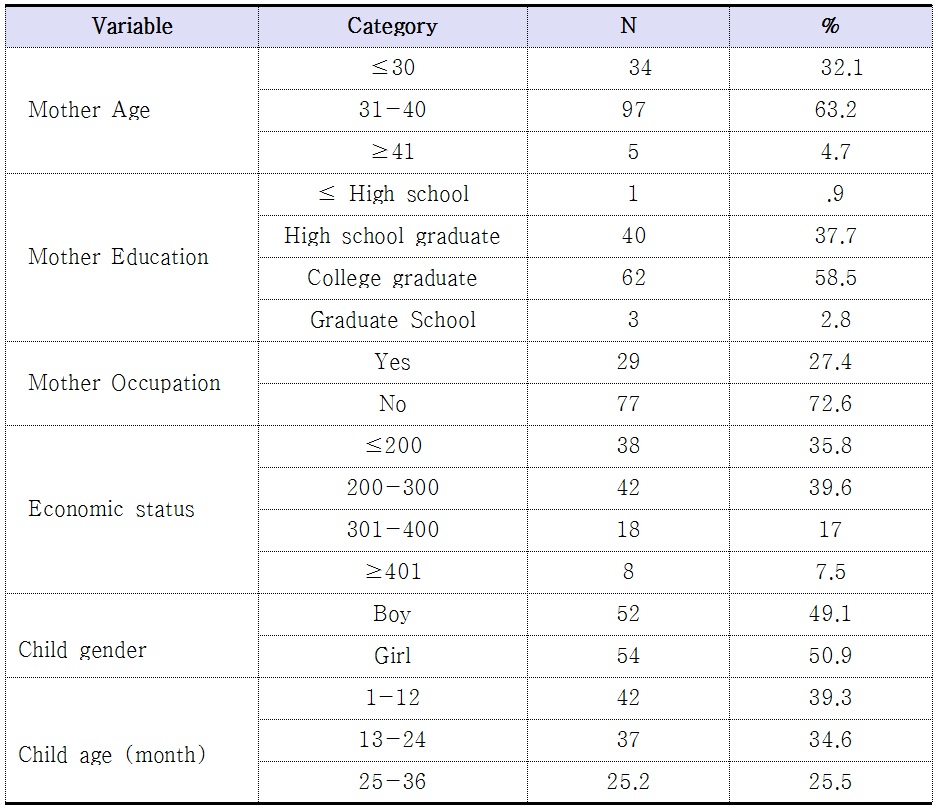
Characteristics of the Participant (N=106)
2. Levels of health promoting behavior and parenting burnout among respondents
The average score of health promoting behavior of mothers for their infants and toddlers was 3.071±.333. Specific scores for each sub-category were as follows: general health promoting behavior was 3.124±.349; general health promoting behavior to improve immunity was 3.071±.558; health promoting behavior through exercise was 3.057±.549; breast-feeding was 2.962±.975; information search on health promotion was 2.953±0.592; tooth health promoting behavior was 2.84±0.571. The average score of parenting burnout was 2.609±.389, and specific scores for each sub-category were as follows: reduction of self-esteem was 2.732±.513; exhaustion was 2.695±.635; depletion was 2.66±.514; apathy was 2.214± 597.
[Table 2.] Score of health promoting behavior, Parenting burnout
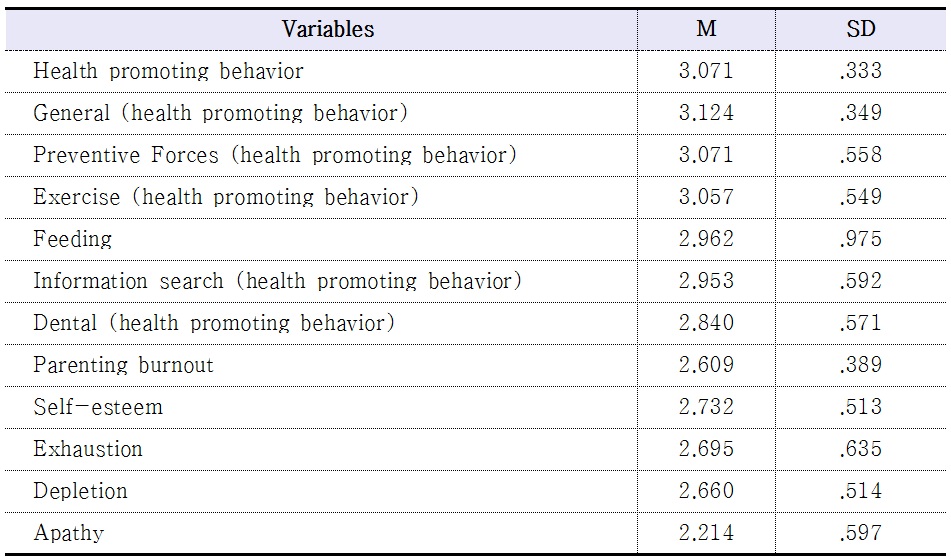
Score of health promoting behavior, Parenting burnout
3. Correlation between health promoting behavior and parenting burnout
Correlation analysis between health promoting behavior for infants and toddlers and parental burnout showed statistically significant negative correlation (r=-.278).
[Table 3.] Correlation between health promoting behavior & Parenting burn out (N=106)

Correlation between health promoting behavior & Parenting burn out (N=106)
4. The effect of health promoting behavior on parenting burnout
To analyze the effect of health promoting behavior on exhaustion, sub-category of parenting burnout, multiple regression analysis was performed. It was not statistically significant at 95% confidence level (R²=.067, F=1.174, p>.05). But, the effect of tooth health promoting behavior, sub-category of health promoting behavior, was statistically significant at 95% confidence level (β=-.223, p<.05).
[Table 4.] Effect of health promoting behavior on exhaustion (N=106)
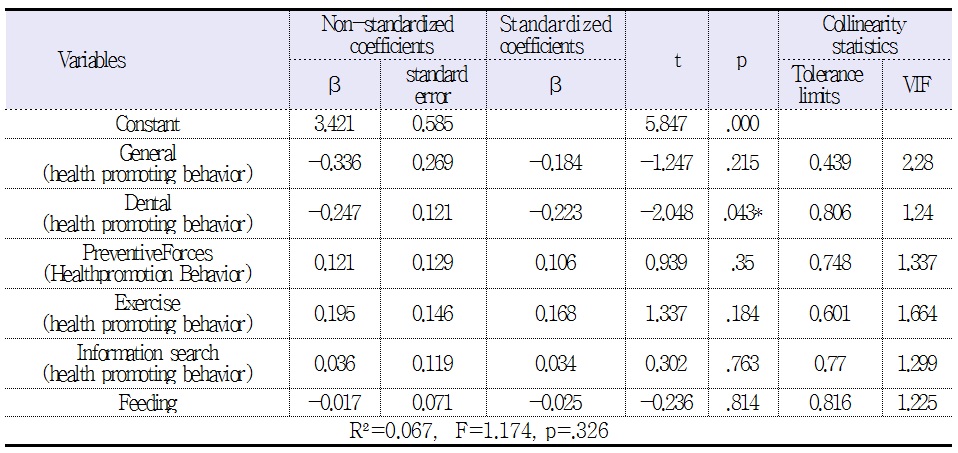
Effect of health promoting behavior on exhaustion (N=106)
To analyze the effect of health promoting behavior on reduction of self-esteem, multiple regression analysis was conducted, and, it was found that it is statistically significant at 99.9% confidence level (R²=.229, F=4.849, p<.001), and that the effect of general health promoting behavior, sub-category of health promoting behavior, is statistically significant at 95% confidence level (β=-.342, p<.05).
[Table 5.] Influence Factors on health promoting behavior & Self-esteem (N=106)
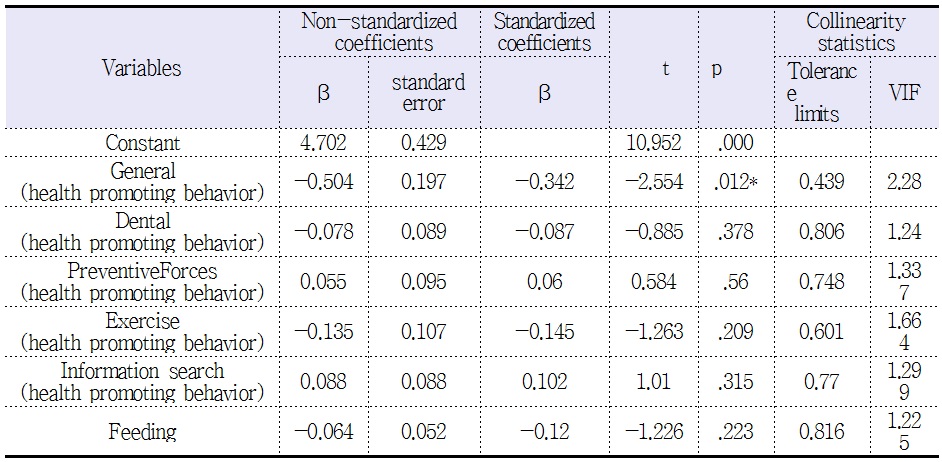
Influence Factors on health promoting behavior & Self-esteem (N=106)
To analyze the effect of health promoting behavior on apathy, multiple regression analysis was conducted. It was found that the effect was statistically significant at 95% confidence level (R²=.133, F=2.513, p<.05).
[Table 6.] Influence Factors on health promoting behavior & Apathy (N=106)
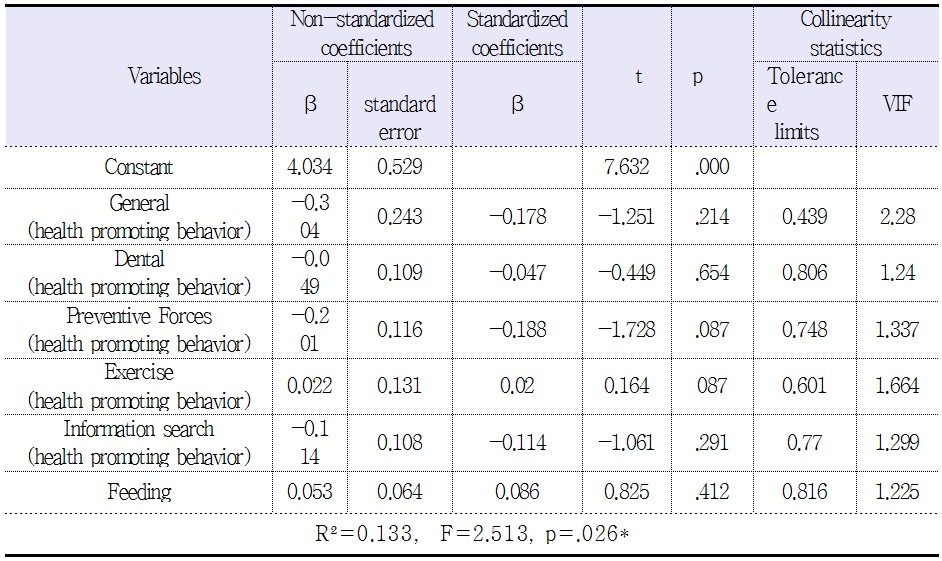
Influence Factors on health promoting behavior & Apathy (N=106)
To analyze the effect of health promoting behavior on depletion, multiple regression analysis was conducted. It was found that the effect was not statistically significant at 95% confidence level (R²=.041, F=.695, p>.05).
[Table 7.] Influence Factors on health promoting behavior & Depletion (N=106)
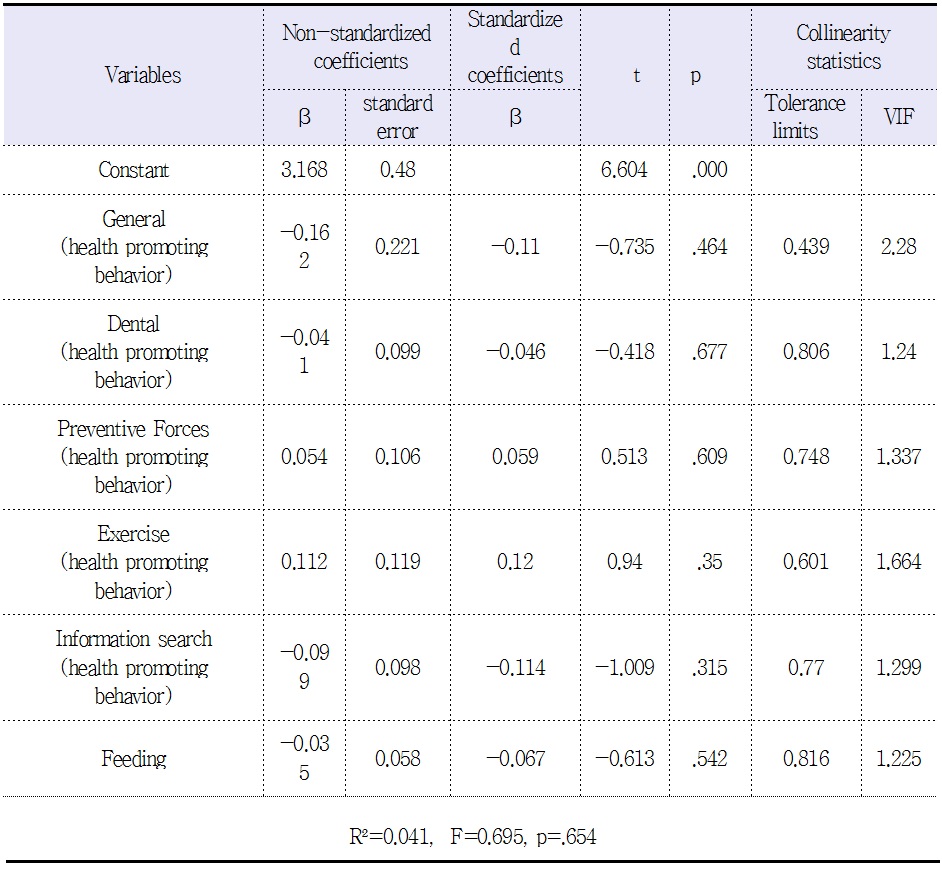
Influence Factors on health promoting behavior & Depletion (N=106)
The multiple regression analysis to examine the effect of health promoting behavior on parenting burnout showed statistically significant relationship at 99% confidence level (R²=.162, F=3.157, p<.01). Among its sub-categories, general health promoting behavior has effect on parenting burnout at 95% confidence level (β=-.335, p<.05).
[Table 8.] Influence Factors on health promoting behavior & Parenting burn out (N=106)
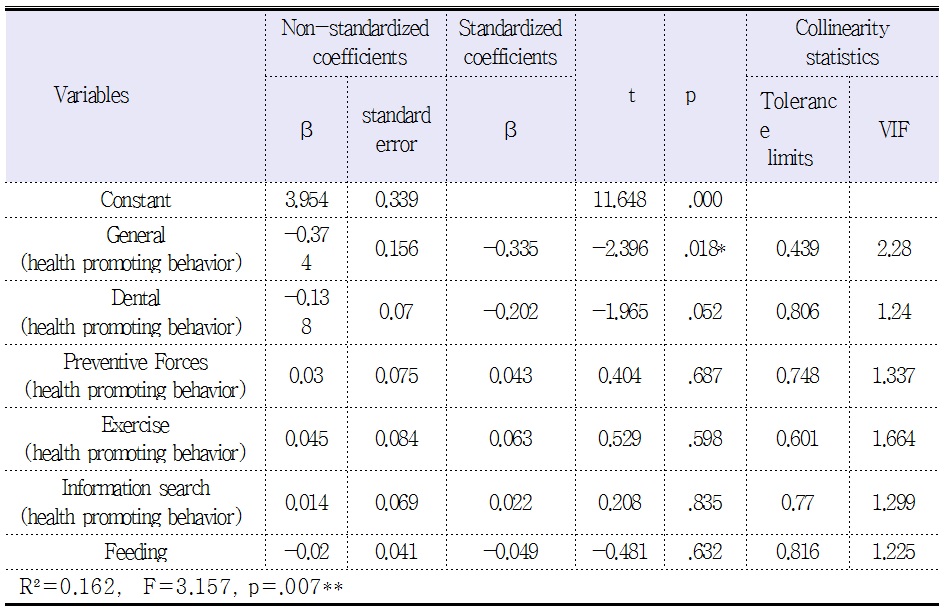
Influence Factors on health promoting behavior & Parenting burn out (N=106)
To examine the effect of health promoting behavior on exhaustion controlling socio-demographic variables such as age, educational level, monthly income, and job, hierarchical multiple regression analysis was conducted, and the result was not statistically significant at 95% confidence level (R²=.022, F=.564, p>.05). In the first stage regression analysis, to examine the effects of all the sub-categories of health promoting behavior ― general health promoting behavior, tooth health promoting behavior, immunity-enhancing health promoting behavior, health promoting behavior through exercise, information search on health promoting behavior, and breast-feeding ― on exhaustion, hierarchical multiple regression analysis was conducted, and the result was not statistically significant at 95% confidence level (R²=.094, F=.975, p>.05). Among all the sub-categories, the effect of tooth health promoting behavior was statistically significant at 95% confidence level (β=-.225, p<.05).
[Table 9.] Influence Factors on health promoting behavior & Exhaustion (N=106)
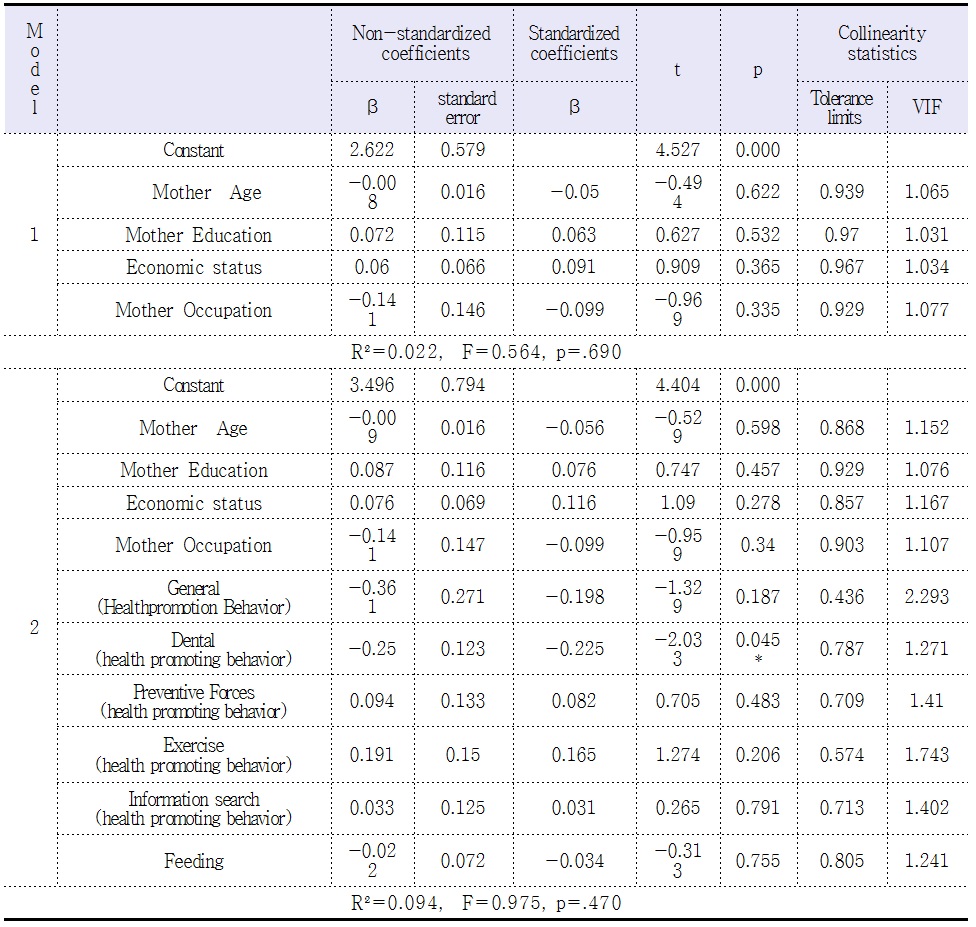
Influence Factors on health promoting behavior & Exhaustion (N=106)
To examine the effect of health promoting behavior on reduction of self-esteem controlling socio-demographic variables such as age, educational level, monthly income, and job, hierarchical multiple regression analysis was conducted, and the result was not statistically significant at 95% confidence level (R²=.063, F=1.674, p>.05). In the first stage regression analysis, to examine the effects of all the sub-categories of health promoting behavior ― general health promoting behavior, tooth health promoting behavior, immunity-enhancing health promoting behavior, health promoting behavior through exercise, information search on health promoting behavior, and breast-feeding ― on exhaustion, hierarchical multiple regression analysis was conducted, and the result was statistically significant at 99.9% confidence level (R²=.276, F=3.582, p<.001). Among all the sub-categories, the effect of general health promoting behavior was statistically significant at 95% confidence level (β=-.363, p<.01).
[Table 10.] Influence Factors on health promoting behavior & Self-esteem (N=106)
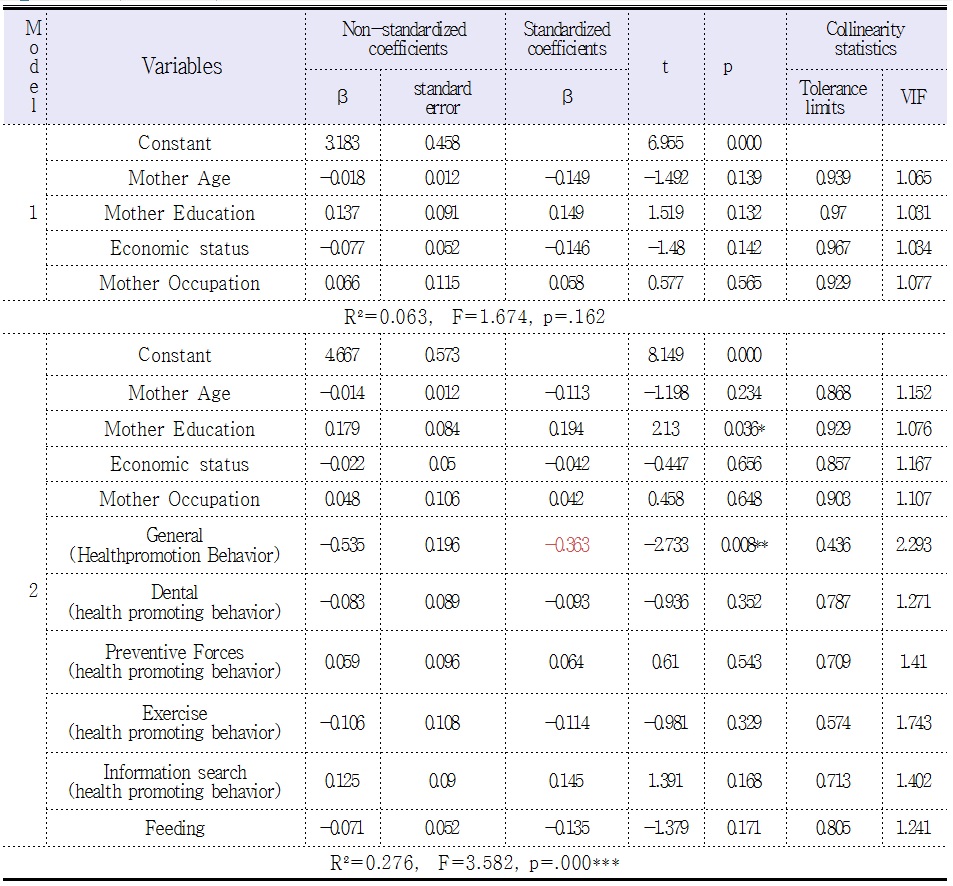
Influence Factors on health promoting behavior & Self-esteem (N=106)
To examine the effect of health promoting behavior on apathy controlling socio-demographic variables such as age, educational level, monthly income, and job, hierarchical multiple regression analysis was conducted, and the result was not statistically significant at 99% confidence level (R²=.132, F=3.793, p<.01). Among all the sub-categories, the effect of monthly income was statistically significant at 99% confidence level (β=-.328, p<.01). In the first stage regression analysis, to examine the effects of all the sub-categories of health promoting behavior ― general health promoting behavior, tooth health promoting behavior, immunity-enhancing health promoting behavior, health promoting behavior through exercise, information search on health promoting behavior, and breast-feeding ― on apathy or reduction of interest in caring child, hierarchical multiple regression analysis was conducted, and the result was statistically significant at 99% confidence level (R²=.214, F=2.553, p<.01).
[Table 11.] Influence Factors on health promoting behavior & Apathy (N=106)
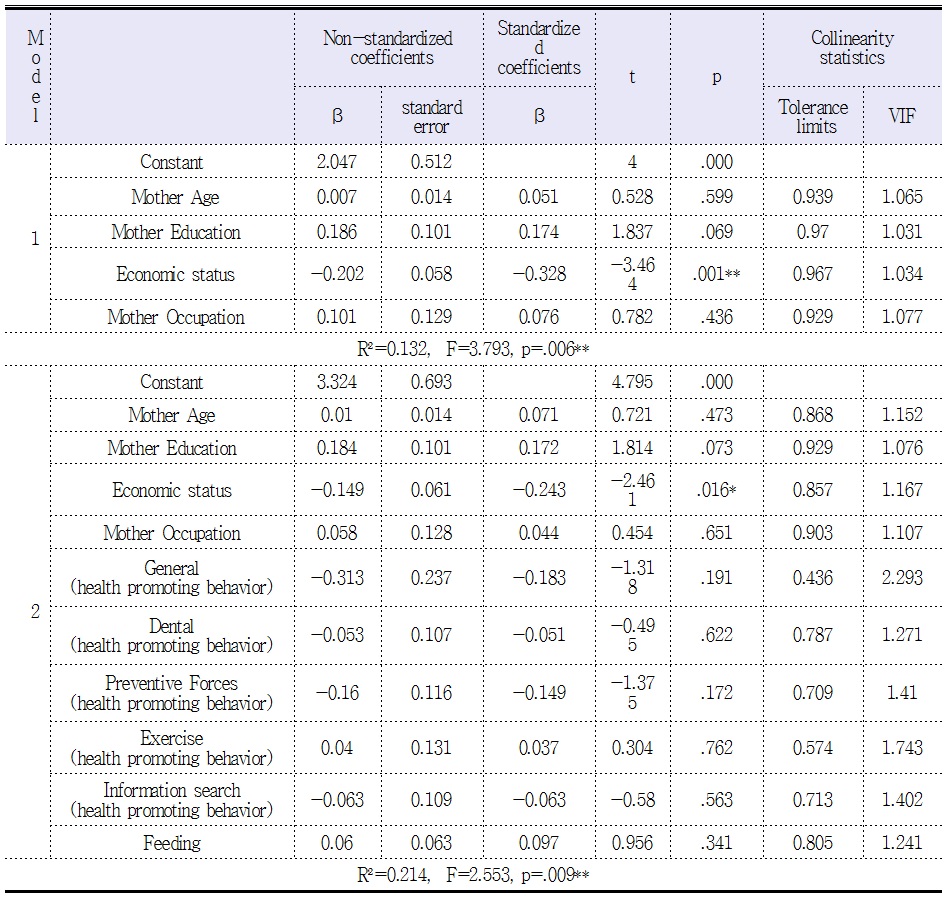
Influence Factors on health promoting behavior & Apathy (N=106)
To examine the effect of health promoting behavior on depletion controlling socio-demographic variables such as age, educational level, monthly income, and job, hierarchical multiple regression analysis was conducted, and the result was not statistically significant at 99% confidence level (R²=.038, F=.981, p>.05). In the first stage regression analysis, to examine the effects of all the sub-categories of health promoting behavior ― general health promoting behavior, tooth health promoting behavior, immunity-enhancing health promoting behavior, health promoting behavior through exercise, information search on health promoting behavior, and breast-feeding ― on depletion, hierarchical multiple regression analysis was conducted, and the result was not statistically significant at 95% confidence level (R²=.084, F=.864, p>.05).
[Table 12.] Influence Factors on health promoting behavior & Depletion (N=106)
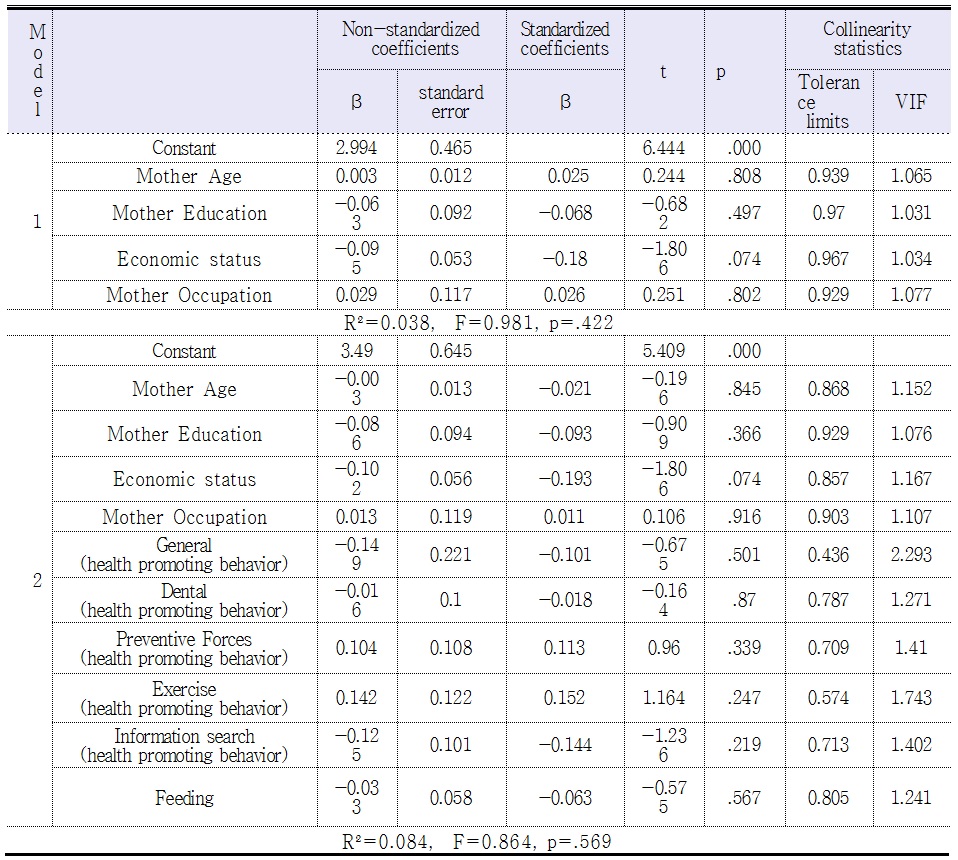
Influence Factors on health promoting behavior & Depletion (N=106)
To examine the effect of health promoting behavior on overall parenting burnout controlling socio-demographic variables such as age, educational level, monthly income, and job, hierarchical multiple regression analysis was conducted, and the result was not statistically significant at 99% confidence level (R²=.042, F=1.093, p>.05). In the first stage regression analysis, to examine the effects of all the sub-categories of health promoting behavior ― general health promoting behavior, tooth health promoting behavior, immunity-enhancing health promoting behavior, health promoting behavior through exercise, information search on health promoting behavior, and breast-feeding ― on parenting burnout, hierarchical multiple regression analysis was conducted, and the result was statistically significant at 95% confidence level (R²=.196, F=2.299, p<.05). Among all the sub-categories, the effect of general health promoting behavior was statistically significant at 95% confidence level (β=-.354, p<.05).
[Table 13.] Influence Factors on health promoting behavior & Parenting burnout (N=106)
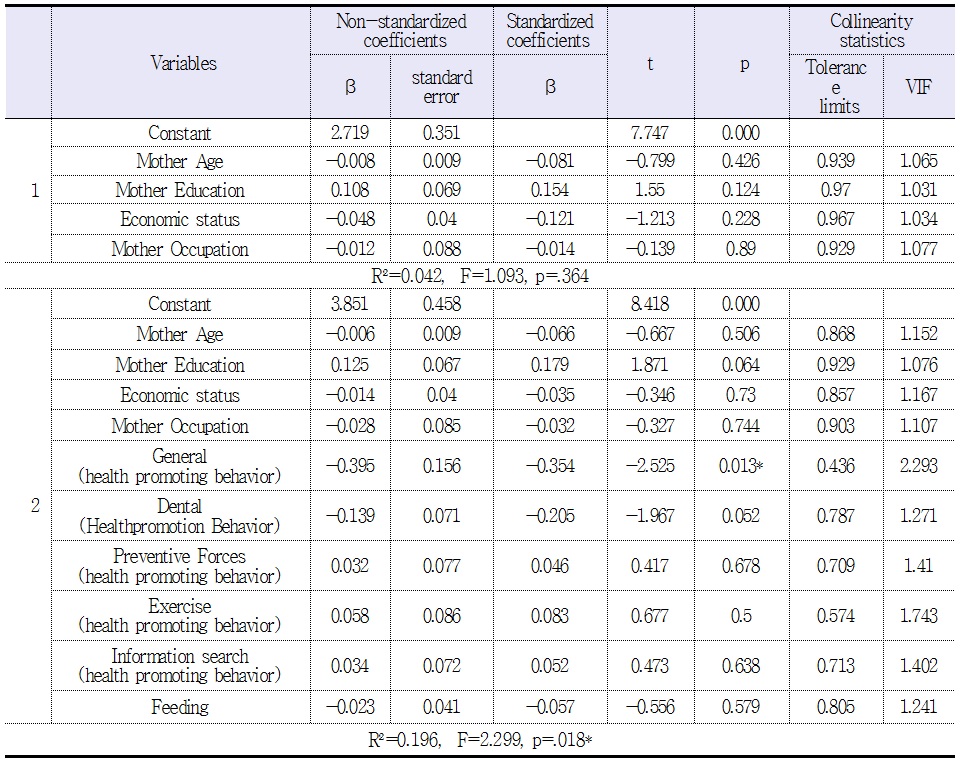
Influence Factors on health promoting behavior & Parenting burnout (N=106)
The infant and toddler period is an important development stage, and health promoting behavior provided by care-taker can have great effects on not only growth and health of children, but health habits and health levels in adolescent and adult periods.
This study intended to examine the relationship between health promoting behavior of mothers given to infants and toddlers and parenting burnout. The findings of the analysis focusing on the research questions are as follows. First, the average score of health promoting behavior of mothers given to infants and toddlers was 3.07 out of 5, full score. The scores of sub-categories of health promoting behavior were as follows: general health promoting behavior 3.124; immunity-enhancing health promoting behavior 3.071; health promoting behavior through exercise 3.057; breast-feeding 2.962; information search on health promoting behavior 2.953; tooth health promoting behavior 2.84. The score of general health promoting behavior was higher than those of breast-feeding, information search, and tooth health promoting behavior. The corresponding score found by Jeong (2009) was 3.21, and that of Shin (2010) was 3.26, and that of Chung (2011) was 3.31, all of which were lower than the score found by this research. Such findings seem to reflect the heightened interest among mothers in caring infants and toddlers caused by low birthrate, and they are positive for health promoting behavior for infants and toddlers.
But, the tool used in this research was the subjective responses of mothers to the questions on health promoting behavior for their children. Thus, it has limits in the sense that it is impossible to know whether mothers actually practice what they argue they do. It also should be considered that the number of questions in this research was different from the cases of other researches. Among the sub-categories of health promoting behavior, scores of breast-feeding and tooth health promoting behavior were a little lower than those of other sub-categories. The findings imply that it is necessary to publicize and educate the importance of breast-feeding to those mothers, and that, considering the low rate of positive answer on the question, 'I don't give my child sweet food or drinks between meals', infants and toddlers are vulnerable to tooth decay. Since it is desirable to take care of teeth from 18 months old when milk teeth begin to emerge, mothers need to care teeth of their children. It is important to educate mothers on health education on dental care of children from the time milk teeth appear to two and half years old.
Second, if unbearable parenting stress keeps accumulating, the phenomenon of parenting burnout, that is the situation of mental exhaustion such as tiredness, frustration, psychological emaciation, and feeling of helplessness appears(Skovholt, 2003). Overall score of parenting burnout was 2.609. Specifically, the score of decrease of self-esteem, a sub-category of parenting burnout, shown as various phenomena such as thinking herself as being unhappy, unsatisfaction with achievement and depression, low morale, loss of ability, and sense of powerlessness to respond was 2.732; that of exhaustion, overcharged condition was 2.695; that of emotional depletion which is symptoms of feeling over-burdened for health promoting behavior and lessening interest and passion for it, and emotional burden was 2.66; that of apathy which is the feeling that they are not related with health promoting behavior for infants and toddlers was 2.214, the lowest score. Even if the degree of parenting burnout was not high, it is necessary to prevent the degree from going up, and to provide mothers with emotional support and encouragement, knowledge, and information.
Third, the analysis of the relationship between health promoting behavior and parenting burnout revealed negative relationship between the two, which means that the lower parenting burnout is, the higher the level of health promoting behavior of mothers gets. According to Sin (2010), the higher social status of mother is, the more often she performs health promoting behavior, and the better she can do it. Since parenting burnout acts negatively on making infants and toddlers grow healthily, it is necessary to find ways to boost self confidence of mothers in caring children to make them do health promoting behavior while reducing parenting burnout. Although health promoting behavior was found not to affect exhaustion and depletion, it negatively affects decrease of self-esteem and apathy. As shown by Woo (2014), physical burden, in the process of rearing children, has the greatest effect on depletion among sub-categories of parenting burnout, apparently a strong element affecting burnout. such a finding is consistent with the results of Hong(2009) and Nam(2010) showing that long-time excessive stress causes burnout.
Forth, when age, educational level, and job were controlled, health promoting behavior was found not to affect exhaustion, depletion, and decrease of self-esteem. But, it was found that monthly income, apathy, and tooth health promoting behavior have significant and negative effects. Breast-feeding was found to significantly affect the decrease of self-esteem, and that general health promoting behavior, tooth health promoting behavior, immunity-enhancing health promoting behavior, health promoting behavior through exercise, and information search on health promoting behavior have significant effects on mothers when they are passive and not very interested in caring their children.
In conclusion, since the infant and toddler period is the state where their all physical, emotional, and cognitive elements develop, it is important above all else to make them grow and develop properly. If the works for the development of infants and toddlers are not performed properly, the next state development is postponed or hindered, negatively affecting the development they should go through in their school ages and in their adulthood. When a mother rears her child, emotion-and health-related information provided by her neighbors gives emotional support and psychological stability, leading her to do health promoting behavior properly.
Based on the findings of the analysis, this research intends to give the following suggestions.
First, the findings have some limits in generalizing them, in the sense that the findings are derived from mothers who used a local medical center selected for convenience of the researcher. But, despite such limits, the findings are meaningful in the sense that they proved for the first time that parenting burnout of mother is an important element affecting her health promoting behavior.
Second, considering that the number of variables related with health promoting behavior in this research is small. it is necessary to increase the number of them.
Third, given that interests among mothers in promoting health of infants and toddlers caused by various elements such as low birthrate, nuclear family, increasing number of married women who have jobs, environmental change and improvement of economic situations, it is desirable to develop health promotion programs and find ways to reduce parenting burnout.












